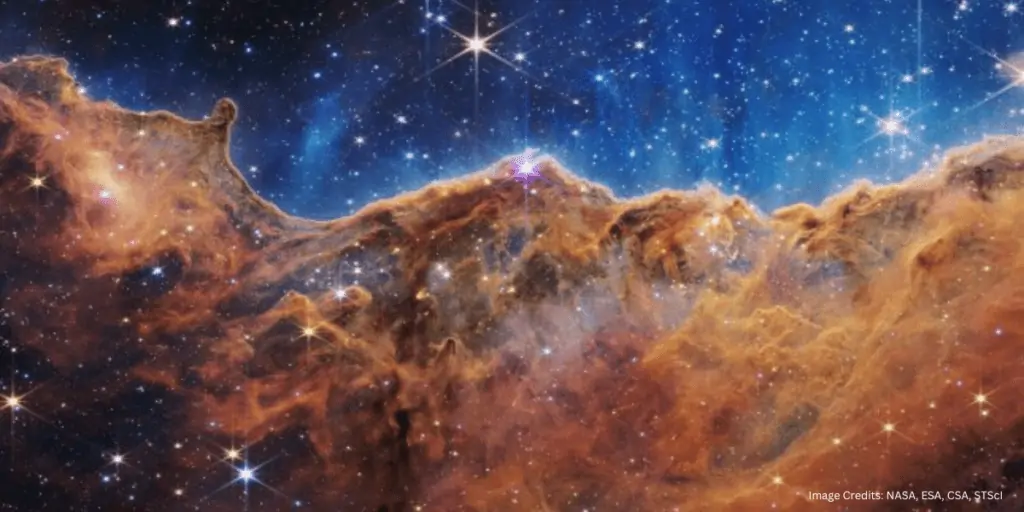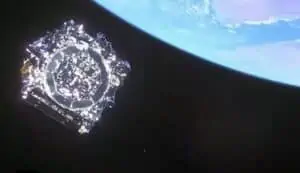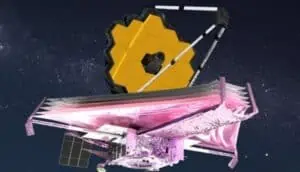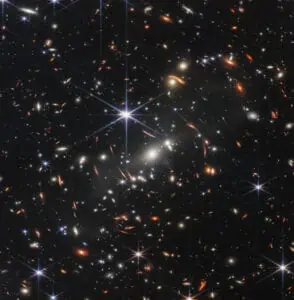The James Webb Telescope image captured by its highly sensitive infrared camera unfolded a lot of hidden queries about deep space, star formation, star dying, and the atmospheric composition of exoplanets.
Table of Contents
Toggle
The James Webb Space Telescope (JWST) is a space telescope designed primarily to study astronomical objects using infrared (IR) radiation i.e. the wavelength of light ranges from 0.75 to 300 micrometers and falls in between visible radiation, which ranges from 380 to 750 nanometres, and submillimetre waves.
It is the largest optical telescope in space containing high IR resolution and sensitivity, due to which it can capture images of objects too early, distant, or faint.
Therefore, scientists are expecting that the James Webb Telescope images will help in the analysis and investigations across the fields of astronomy and cosmology.
The investigations will include observations of the first stars and the first galaxies formation and detailed atmospheric characterization of potentially habitable exoplanets.
The name of the telescope was given “James Webb Space Telescope” after James E. Webb, who worked as the administrator of NASA from 1961 to 1968 during the Gemini, Mercury, and Apollo programs.
The James Webb Space Telescope was launched on 25 December 2021 on an Ariane 5 rocket, a European heavy-lift space launch vehicle developed and operated by Arianespace for the European Space Agency (ESA) from Kourou, French Guiana.
The telescope arrived at the Sun-Earth L2 Lagrange point (about 1.5 million kilometers (930,000 mi) from Earth) in January 2022.

The first image of the James Webb Telescope (JWST) was released into the public domain via a press conference on 11 July 2022.
Here we have collected some James Webb Space Telescope images and their illustrations for the circulation of knowledge and information to our readers.
Like the Hubble Telescope is not orbiting the Earth and is floating at a certain location in space known as Lagrange point, which is nearly 1 million miles away from Earth.
Lagrange Points
A Lagrange point is a location in space where the combined gravitational forces of a two-body system like the Sun and Earth equals the repulsion force or centrifugal force felt by a much smaller third body such as spacecraft.
This interaction of the forces creates a point of equilibrium where a spacecraft may be “parked” to make observations with reduced fuel consumption needed to remain in position.
This point is named in Honour of Italian-French Mathematician Josephy-Louis Lagrange of the 18th century.

They are five Lagrange points (L1, L2, L3, L4, and L5) found around major bodies such as plants or a star three are unstable (L1, L2, and L3) and two are stable (L4 and L5).
The L1, L2, and L3 points lie along the line connecting the two large masses such as the Sun and Earth, whereas L4 and L5 are from the apex of two equilateral triangles that have large masses at their vertices.
Check: Best Five Star Projectors: Bringing the Cosmos into Your Home
The L1 point gives an unerupted view of the sun but is currently occupied by the solar and Heliospheric Observatory (SOHO) and Deep Space Climate Observatory.
However, the L2 point lies in the opposite direction of the sun, a million miles from earth, and currently, the Wilkinson Microwave Anisotropy Probe (WMAP), Plank, and James Webb Telescope of NASA occupied this point.
At this point, the spacecraft can keep the Earth, Moon, and Sun behind for collecting solar power, provide a clear view of deep space for the telescope, and can readily communicate with earth.
Whereas, according to NASA, the L3 point is situated hidden behind the sun at all times and is still under investigation, but this point had been a very popular topic for science fiction writers.
Further, as the L4 and L5 points are stable, dust and asteroids tend to accumulate in these regions.
The asteroids found in these regions are called Trojans in the honor of the asteroids Agamemnon, Achilles, and Hector, which are found between Jupiter and the Sun.
According to NASA, there are thousands of these types of asteroids found in our solar system.

The infrared vision of the telescope can peer 13.5 billion years into the Universe’s past i.e., can see the light formed after the Big Bang during the formation of the first stars and galaxies.
The complex design consists of a tennis court-sized sun shield observatory and took about 300 procedures to unfurl to keep the instrument in cooling condition as well as protect it from harmful cosmic rays.
Therefore, the instrument should be so cold i.e., -370-degree F, that sunlight or even Webb’s own thrusters could cause interference. The sun shields the walls of the instruments from the heat.
The super-cooled infrared instruments will be helpful for the observation of the galaxies, black holes, and exoplanets that formed 13.5 billion years ago, the earliest ever seen.
The cost of the James Webb Space Telescope is $10 billion, possesses 18 hexagonal gold-plated mirrors, which gather light from the depths of the Universe and reflect those lights towards a collector of an instrument that collects it.
The mirror of the telescope measures 21 feet across, which is significantly larger than Hubble’s primary mirror, which is 7.9 feet across.
This larger-sized mirror helps Webb’s telescope to collect more light and a better view of distantly present objects.


Arianespace’s Ariane 5 rocket (European heavy-lift space launch vehicle) lifted off carrying the telescope at 7:20 a.m. EST on Dec. 25 from the Guiana Space Centre in French Guiana.
The rocket has been used to deliver payloads in geostationary transfer orbit (GTO), a highly elliptical Earth orbit with an apogee of 42,164 km (26,199 mi), or 35,786 km (22,236 mi) above sea level or low Earth orbit (LEO).
It is the closest orbit to the Earth’s surface, approximately 111–1,242 miles above sea level (180–2,000 km).
The lunch vehicle had 82 consecutive successful launches between 9 April 2003 and 12 December 2017 and since 2014, Ariane 6, a direct successor system, is in development.
You May Also Read: Space Pens or Pencils: How NASA Takes Notes in Space
James Webb Telescope image revealed “Cosmic Cliffs”
NASA’s James Webb Space Telescope reveals emerging stellar nurseries (an area of outer space within a dense nebula in which gas and dust are contracting, resulting in the formation of new stars) and individual stars in the Carina Nebula.
This image is captured in infrared light by the Near-Infrared Camera (NIRCam) on NASA’s James Webb Space Telescope and this image reveals previously invisible areas of star birth.
The image depicts the much like craggy mountains on a moonlit evening is actually the edge of a nearby, young, star-forming region NGC 3324 in the Carina Nebula.

“cosmic cliffs and a sea of stars.” (Image Credit: NASA, ESA, CSA, STScI)
The image of NGC 3324 was captured by James Webb Telescope’s Near-Infrared Camera (NIRCam) and Mid-Infrared Instrument (MIRI).
The MIRI is able to capture the formation of young stars and their dusty, planet-forming disks shine brightly in the mid-infrared, appearing pink and red.
The hydrocarbons, hot dust, and other chemical compounds on the surface of the ridges glow and appear as jagged rocks with MIRI.
This image of “Cosmic Cliffs” proves capabilities to peer through cosmic dust and shed new light on how stars form due to the possession of extreme sensitivity, spatial resolution, and imaging capability.
However, in objects in the earliest, it is difficult to capture the rapid phases of star formation.
Cosmic Cliffs
Cosmic Cliffs is the region of “mountains” and “valleys” speckled with glittering stars is actually the edge of a gigantic, gaseous cavity within NGC 3324 (an open cluster in the southern constellation Carina, located northwest of the Carina Nebula (NGC 3372) at a distance of 9,100 light years) and the region is located around 7,600 light-years away.
The cavernous area has been engraved from the nebula by the intense stellar winds from extremely hot, massive young stars and ultraviolet radiation located in the center of the bubble, above the area shown in this image.
The energy radiation from these young stars is shaping the nebula’s wall by slowly destroying it away. The tallest “peaks” in this image are depicted 7 light-years high.
The “steam” that appears to rise from the celestial “mountain” is actually hot, ionized gas and hot dust streaming away from the nebula due to the relentless radiation.
Webb’s camera also revealed the emerging stellar nurseries and individual stars which are completely hidden in the visible-light pictures.
Stephan’s Quintet image of the James Webb Telescope

NASA’s James Webb Telescope image also revealed never-before-seen details of galaxy group “Stephan’s Quintet”
Stephan’s Quintet, a visual grouping of five galaxies, of which four form a physical association, a true galaxy group, Hickson Compact Group 92 (HCG92), and will likely merge with each other.
Although called a “quintent”, the only images of four galaxies with physical associations are captured by the Webb in a cosmic dance.
This mosaic James Webb Telescope image is the largest image to date, covering about one-fifth of the moon’s diameter.
This image contains over 150 million pixels and is constructed from almost 1,000 separate image files.
This picture is also revealing the galactic interactions and how they have driven the galaxy’s evolution in the early universe.
The fifth and leftmost galaxy called NGC 7320 resides 40 million light-years from the Earth, while four other galaxies (NGC 7317, NGC 7318A, NGC 7318B, and NGC 7319) are present about 290 million light-years away.
James Webb Telescope image revealed Dying Star’s final “Performance”

The previously hidden shells of gas and ejecting dust from dying stars of the Southern Ring planetary nebula are also revealed by NASA’s James Webb telescope image.
These types of newly discovered details will help to explore the late stages of a star’s life as well as help for a better understanding of their evolution and transformation of environments.
These images also reveal a cache of distant galaxies in the background and most of the multi-colored points of light seen in the image are galaxies – not stars, approximately 2,500 light-years away.
After this image, astronomers are expecting that this telescope will help them to refine their knowledge of the presence of molecules in the expelled clouds of gases and dust of dying stars.
Webb will allow astronomers to dig into many more specifics about planetary nebulae like this one – clouds of gas and dust expelled by dying stars.
Understanding which molecules are present, and where they lie throughout the shells of gas and dust will help researchers refine their knowledge of these objects.
According to the observation of NASA, the Southern Ring Nebula is almost face-on, its three-dimensional shape more clearly looks like two bowls placed together at the bottom, opening away from one another with a large hole at the center.
The widest shells of gas toward the outer areas of the image were ejected earlier whereas those closest to the star are the most recent and each shell represents an episode where the fainter star lost some of its mass.
The brighter star is in an earlier stage of its stellar evolution and will probably eject its own planetary nebula in the future. Thus, trancing these ejections allows researchers to the history of the system.
During the ejection of the shells of materials (dust and molecules) from the star, its shape gradually changed, and thus dust eventually enriches the area around it and expands.
This surrounding of dust around the star is called the interstellar medium. This process is very long-lived and the dust gradually travels through space for billions of years and becomes incorporated into a new star or planet.
Finally, in thousands of years, these delicate layers of gas and dust will disintegrate into surrounding space.
James Webb Telescope revealed the steamy atmosphere of exoplanet planet

This picture depicts a composition with a distinct signature of water of planetary atmosphere situated nearly 1,150 light years away.
This finding of water by the James Webb Telescope is also hinting that it can play a significant role in searching for potentially habitable planets in coming years.
Further, the powerful new view in comparison to the previous studies also shows evidence of haze and clouds in the atmosphere surrounding a hot, puffy gas giant planet orbiting a distant Sun-like star.
The observation also reveals that the presence of specific gas molecules based on tiny decreases in the brightness of precise colors of light, is the most detailed of its kind to date, hundreds of light-years away.
To date there are more than 5,000 exoplanets confirmed in the Milky Way and WASP-96 b is one, located roughly 1,150 light-years away in the southern-sky constellation Phoenix.
It looks like a gas giant and represents no direct analog in our solar system. The mass of WASP-96 is half of Jupiter and has 1.2 times the greater diameter.
In comparison to any other plant orbiting Sun, WASP-96 b has a much puffier atmosphere and is hotter with a temperature greater than 1000-degree F and close proximity to the Sun.
The Near-Infrared Imager and Slitless Spectrograph (NIRISS) of the Webb telescope measured light from the WASP-96 system for 6.4 hours while the planet moved across the star.
This data shows a light curve and transmission spectrum.
While the light curve confirmed the properties of the planet (existence, size, and orbit of the planet), which was previously determined and the transmission spectrum reveals the hidden details of the atmosphere like the signature of water, indications of haze, and evidence of clouds.
The image of the spectrum of WASP-96 b captured by the James Webb Telescope’s NIRISS is indicating not only the most detailed near-infrared transmission spectrum of an exoplanet atmosphere but also significantly covers a wide range of wavelengths.
These include visible red light and an undiscovered portion spectrum (wavelengths longer than 1.6 microns), which was not previously accessible by other telescopes.
Particularly, this part of the spectrum is sensitive to water as well as other key molecules like oxygen, methane, and carbon dioxide, which are not immediately obvious in the WASP-96 b spectrum but should be detectable in other exoplanets planned for observation by Webb.
By using the NIRISS data of the Webb Telescope, researchers will be able to measure the amount of water vapor in the exoplanet’s atmosphere and other elements like carbon and oxygen and estimate atmospheric temperature with depth.

The James Webb Telescope image shows a patch of sky approximately the size of a grain of sand held at arm’s length by someone on the ground and also reveals thousands of galaxies in a tiny sliver of the vast universe.
Also proves its capability to explore the universe by giving faint structures in extremely distant galaxies the most detailed view of the early universe to date.
This deep field image was taken by James Webb Telescope’s Near-Infrared Camera (NIRCam) and is a composite made from images at different wavelengths in a total of 12.5 hours to achieve depth at infrared wavelengths, whereas the Hubble Space Telescope takes weeks for this deepest field image.
This is only the beginning and researchers will continue to use Bebb to take longer exposure for revealing more about our vast universe.
This deep field, taken by Webb’s Near-Infrared Camera (NIRCam), is a composite made from images at different wavelengths, totaling 12.5 hours – achieving depths at infrared wavelengths beyond the Hubble Space Telescope’s deepest fields, which took weeks.
And this is only the beginning.
Researchers will continue to use Webb to take longer exposures, revealing more of our vast universe.
Further, this image also shows the 4.6 billion years ago galaxy cluster SMACS 0723 with many more galaxies in front of and behind the cluster.
You May Also Read: A newly discovered antibody can neutralize all COVID-19 variants
Webb’s Near-Infrared Camera captured sharply focused images of distantly present galaxies and never been discovered tiny, faint structures, including star clusters and diffuse features.
The light from these galaxies took billions of years to reach us on the earth and we are looking back in time to within a billion years after the big bang when viewing the youngest galaxies in this field.
Some lights are stretched by the expansion of the universe to infrared wavelengths, which can not be seen by our naked eye whether Webb can observe those.
The Webb’s Mid-Infrared Instrument (MIRI) image offers a kaleidoscope of colors and highlights which reveals that dust is – a major ingredient for star formation, and ultimately life itself.
The blue galaxies contain stars with little dust and the red objects in this field are enshrouded in thick layers of dust. The green galaxies consist of an enormous amount of hydrocarbons and other chemicals.
These data will help researchers to understand the process of galaxies formation, how they grow and merge each other and why sometimes they stop forming stars altogether.
The micro shutter array of Near Infrared Spectrograph (NIRSpec) of Webb telescope observed 48 individual galaxies at the same time with full detail about each.

The data reveals that light from one galaxy traveled for 13.1 billion years before Webb’s mirrors captured it.
James Webb Telescope image revealed “Cosmic Tarantula”
The Near-Infrared Camera (NIRCam) of the James Webb Telescope captured this mosaic image stretching 340 light-years across giving birth to thousands of new stars.
The Tarantula Nebula is the largest and brightest star-forming region in the stellar nursery.
By using three of its high-resolution NIR camera, Webb’s telescope captured thousands of never-before-seen young stars’ stunning nursery in a stellar nursery called 30 Doradus.
According to the previous telescope images, its appearance looks like dusty filaments therefore its name was given Tarantula Nebula.
The Tarantula Nebula is situated about 161,000 light-years away in the Large Magellanic Cloud galaxy and is the largest and brightest star-forming region nearest our Milky Way.

Follow us on Facebook.
You May Also Read:
- Never seen “Cosmic Cliff” and Star Formation
- Alice electric plane- the first all-electric passenger airplane prepares to fly
- Purple Tomatoes! Journey from Molecular Lab to Modular Kitchen
- Space Pens or Pencils: How NASA Takes Notes in Space?
FAQ related James Webb Telescope Image
Are there any images from the Webb telescope?
There are a lot of images captured by the James Webb telescope and sent back to earth. These images revealed a lot of hidden mysteries. Please read this article, here all the images of the James Webb telescope are described in depth.
How far can James Webb see?
The James Webb Space Telescope has the capacity to capture objects 13.6 billion light years distant. This is the farthest distance we’ve ever seen into space.
How old are the pictures from James Webb telescope?
The potential of the James Webb Telescope to capture light from 13.6 billion light years distance, clearly indicates their age.
Pictures captured by James Webb Telescope are images of galaxies that existed more than 13 billion years ago, means nearly the beginning of time.
In other words, the James Webb Telescope can capture light that has been traveling through space ever since the beginning of time or the Big Bang.
How many years back can the James Webb telescope see?
The Webb telescope possesses the potential to look around a quarter of a billion years (possibly back to 100 million years) after the Big Bang when the first stars and galaxies started to form.
What is the cost of the James Webb Space Telescope?
The cost of the development process of the James Webb telescope is $10 billion over 17 years.















